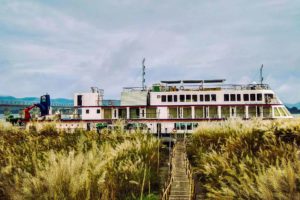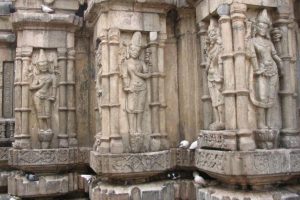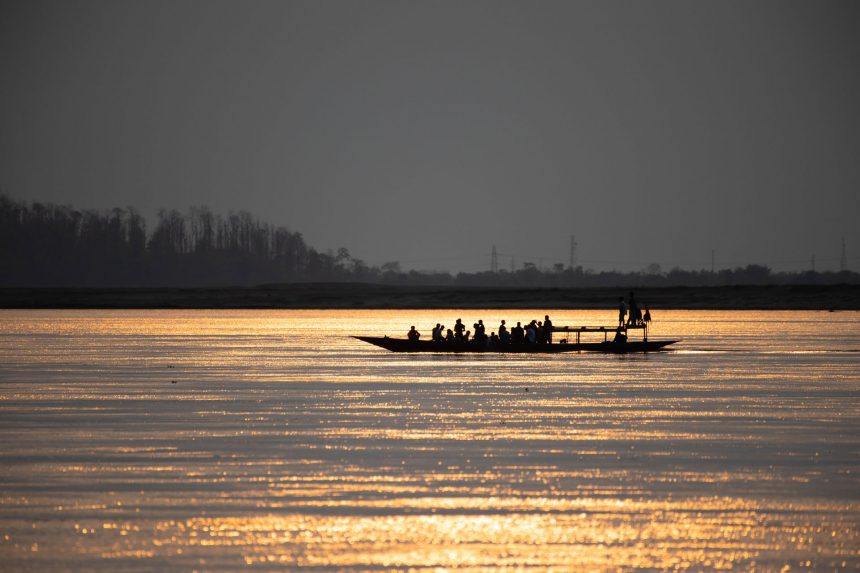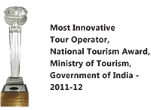What attracts us to the river Brahmaputra?
The river traverses the transboundary geography draining diverse environments; the cold dry plateau of Tibet, the rain drenched Himalayan slopes, the landlocked alluvial plains of Assam and the vast deltaic lowlands of Bangladesh. It is the width of the river where huge sand bars support villages. Majuli, the neo-vaishnav hub is the largest inhabited riverine island, in fact it is a district and the world’s smallest inhabited Peacock Island are both tourist attractions. The UNESCO World Heritage Site of Kaziranga National Park is a product shaped and supported by the river. The expansive and progressive tea estates of Assam too are a product of the same landscape. Rang Ghar, Talatal Ghar and Shiva Dol in Shivasagar are a glimpse into the Ahom culture.
The Brahmaputra’s source is the Chemayungdung Glacier over a 100 km stretch on the slopes of Himalayas which lies to the south-east of Lake Mapam. The three headstreams that arise in this area are Kubi, Angsi and Chemayungdung. These are just trickling streams; barely noticeable.
The Angsi stream gathers other smaller streams and tributaries in itself to be called Yarlung Tsangpo and flows eastwards and then north to Namche Barwa where it takes a U-turn and a sudden southward bend after covering 2519 Km (1565 miles) to enter Arunachal Pradesh at Bishing village near the LOC (Line of Control). Here it is renamed as Siang or Dihang for 35 kilometres (22 miles) and two tributaries of Dibang and Lohit join this river.
 After the confluence of Siang, Dibang and Lohit the river enters Assam at Sadiya and flows through 450 miles (700 km) of Assam Valley. Here at Sadiya and below it spreads to a width of not less than 20 kms. It takes its mightier form when joined by rapidly gushing Himalayan streams or tributaries of Subansiri, Kameng, Bhareli, Dhansiri, Manas, Champawati, Saralbhanga and Sankosh. The Tributaries rising from the Shillong Plateau and the hills on the south side of the river are Burhi Dihing, the Disang, Dikhu and Kopili. When the Brahmaputra waters exit Dhubri to enter Bangladesh, these waters on joining Teesta are named as Jamuna which flows for 205 kms (127 miles) southwards. After this long journey, the river meets Ganges and flows as Padma (Podda) for 120 kms (75 miles). The confluence of Ganga and Jamuna is at Goalundo and the river takes its mighty form. In the downstream the Padma and Meghna converge at Chandpur and the two together submerge to end the journey of 254 km (157 miles) into the Bay of Bengal as Meghna.
After the confluence of Siang, Dibang and Lohit the river enters Assam at Sadiya and flows through 450 miles (700 km) of Assam Valley. Here at Sadiya and below it spreads to a width of not less than 20 kms. It takes its mightier form when joined by rapidly gushing Himalayan streams or tributaries of Subansiri, Kameng, Bhareli, Dhansiri, Manas, Champawati, Saralbhanga and Sankosh. The Tributaries rising from the Shillong Plateau and the hills on the south side of the river are Burhi Dihing, the Disang, Dikhu and Kopili. When the Brahmaputra waters exit Dhubri to enter Bangladesh, these waters on joining Teesta are named as Jamuna which flows for 205 kms (127 miles) southwards. After this long journey, the river meets Ganges and flows as Padma (Podda) for 120 kms (75 miles). The confluence of Ganga and Jamuna is at Goalundo and the river takes its mighty form. In the downstream the Padma and Meghna converge at Chandpur and the two together submerge to end the journey of 254 km (157 miles) into the Bay of Bengal as Meghna.
What is a River Destination?
 A Destination is that place where one reaches and unpacks to spend some time in enjoying the ambience of the area. So, naturally, a river destination would be on the banks of a river or on a river where one can lay back and have the space and expanse to bask in its ambience. A destination generally stands for a fixed spot and it would be our own limbs or the mechanical limbs that would carry us around to explore. What, if, one has a destination that is mobile to explore?
A Destination is that place where one reaches and unpacks to spend some time in enjoying the ambience of the area. So, naturally, a river destination would be on the banks of a river or on a river where one can lay back and have the space and expanse to bask in its ambience. A destination generally stands for a fixed spot and it would be our own limbs or the mechanical limbs that would carry us around to explore. What, if, one has a destination that is mobile to explore?
This revered Brahmaputra is born of Amogha (sage Shantanu’s beautiful wife) and Brahma. Sage Shantanu placed this ‘son of Brahma’ in the middle of Kailash, Gandhamadana, Jarudhi and Sambwartakka, the four mountains. Here this child of Brahma and Amogha grew into a lake called Brahma Kund. Sage Parshuram who was advised penance and a dip in the holy waters of Brahma Kund to absolve himself from the sin of killing his mother. Parshuram noticed the ever-growing child of water and axed down the side of the mountain to bless man-kind with these mineral rich and pristine waters of Brahmaputra.
 On the banks of Brahmaputra are the Nilgiri Hills that are home to the Goddess of Desire, maa Kamakhya. The festival of Ambubachi brings the seers and the devotees to Guwahati to celebrate the fertility of mother earth.
On the banks of Brahmaputra are the Nilgiri Hills that are home to the Goddess of Desire, maa Kamakhya. The festival of Ambubachi brings the seers and the devotees to Guwahati to celebrate the fertility of mother earth.
The main temple is surrounded in a complex of individual temples dedicated to seven Mahavidyas of Shaktism; Kali, Tara, Bhuvneshwari, Bhairavi, Chinnamasta, Dhumavati, Baglamukhi. The 3 Devis; Tripurasundari, Matangi and Kamala reside within the main temple. It is rare to witness the Mahavidyas together in one complex. This makes Kamakhya temple unique.
Cruising onboard MV Mahabaahu
 MV Mahabaahu, is one such destination that sails you on the river Brahmaputra to enjoy soft adventure in a luxury setting, where the crew is at your service to ensure a great experience in a safe and secure environment.
MV Mahabaahu, is one such destination that sails you on the river Brahmaputra to enjoy soft adventure in a luxury setting, where the crew is at your service to ensure a great experience in a safe and secure environment.
You unpack once and settle down for the next seven days and enjoy the play of sand and water of this might sacred body that has been held high by the ancient Bons of Tibet, the Vaishnavites, the Shaivites and Shaktas. The MV Mahabaahu explorers can bathe in forest and river kohora (mist) as their room sails in the shadow of snow-covered peaks that stand tall above 6500 meters.
MV Mahabaahu stands tall in the highly braided river as a destination. MV Mahabaahu is a luxury vessel that sails from Sunday to Sunday, undertaking a 7 Night 8 Day Cruise. The two ends of the Cruise, that is, starting and ending points are Guwahati and Jorhat, that are conveniently connected to an airport, a railway station and enjoy road access.
What is Upstream and Downstream Cruise?
 The season for cruising on Brahmaputra is from October to April. At this time the temperature ranges from 24 to 18 degrees. The river is under flood conditions from July to September. Assam sees hot and humid weather in the month of May and June.
The season for cruising on Brahmaputra is from October to April. At this time the temperature ranges from 24 to 18 degrees. The river is under flood conditions from July to September. Assam sees hot and humid weather in the month of May and June.
On a river, a ship generally moves in two directions; against and along the current of the river. The upstream is against the current and Downstream is along the current. On MV Mahabaahu the Upstream Cruise starts from Pandu Port in Guwahati that has access to Lokpriya Gopinath Bordoloi International Airport and ends in Neamati Ghat of Jorhat that enjoys flight connectivity through Rowriah Airport. So, the cruise enthusiasts can comfortably arrive by flight to Guwahati to board the Ship and can deboard at Jorhat and take a flight to any part of India from Rowriah Airport.
Similarly, the Downstream Cruise brings the guests from different parts of India to the airport in Jorhat to board the Ship and after cruising for 7 nights, one can comfortably disembark at Guwahati to fly out to any part of India. In case, a traveller decides to enjoy the cruise and has some more days to explore further, then a flight to Paro can take you to Bhutan.

















Leave a Reply
You must be logged in to post a comment.